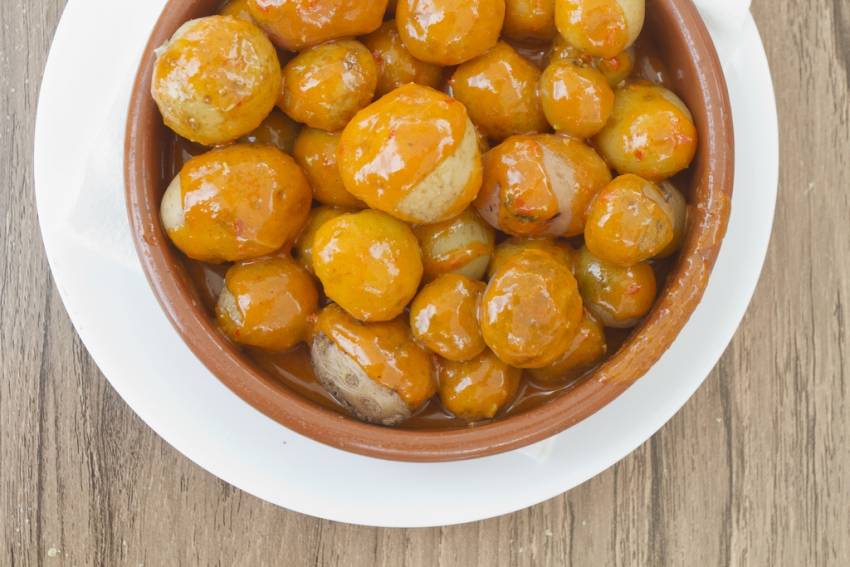The Legendary Red Mojo Sauce: Gran Canaria Recipe
Mojo sauce is the Canary Islands' most famous condiment and one half of "papas arrugadas con mojo", our most popular dish. It is tasty, garlicky and spicy, but not actually that fiery unless you get Mojo Picon; the chilied up version.
Mojo sauce is either red or green (mojo rojo and mojo verde) depending on whether it is flavoured with paprika or fresh coriander. Both types also contain oil, vinegar, cumin, garlic and chili. The red form is served with small, salted potatoes while the green form is traditionally served with fish.
The name mojo probably comes from the Portuguese word molho, which means sauce: A reminder that many early Canarian settlers came from the nearby Portuguese island of Madeira. They migrated to the Canary Islands to start off its sugar cane industry.
Red Mojo Recipe
Makes enough for a good portion of mojo sauce for papas arrugadas for four people.
Ingredients
5 garlic of cloves
A teaspoon of cumin seeds
2 or 3 dried birds eye chilies, more for Mojo Picon
A good pinch of salt
A teaspoon of smoky paprika or pimentón
3 tablespoons red wine vinegar
5 tablespoons olive oil
3 or 4 tablespoons breadcrumbs to thicken
A splash of water to loosen the sauce, or a couple of roasted tomatoes.
Method
Dry fry the cumin until it starts to pop to release its flavours. Grind it up in a pestle and mortar along with the dried chilies, salt, pimentón and the garlic cloves until you get an even paste. Add the olive oil and vinegar and mix well. Add breadcrumbs to thicken and water to loosen. Mojo should be thick enough to stick to the potatoes but not be lumpy.
Mojo Rojo is almost always served with papas arrugadas: Small potatoes cooked in sea water or very salty water. The salt sucks water out of the potatoes, leaving them with wrinkled skin.
To make papas arrugadas boil small potatoes in just enough sea water or salty water to cover them. Leave the pan uncovered and cook until the water is almost all gone. Leave them in the open pan until they are dry and the skin is covered with a fine white crust of salt.
To make proper papas con mojo pour the sauce generously over the potatoes rather than in a separate dish. Squash each potato before removing it from the sauce for maximum absorption. Papas con mojo goes brilliantly with good Canarian goat's cheese.
"Horrible" Gofio: The Canary Island Soul Food
Gofio is soul food in the Canary Islands. Most Canarians were weaned on bananas mashed up with gofio and many still eat it every day. It is so tightly entwined with local identity that it is best not not to tell anyone on the islands if you don't like it. At the same time Canarians aren't stupid. They enjoy cake and chocolate and ice cream just like everyone else. They wouldn't eat gofio if it was horrible. Wwould they?
Gran Canaria Foods That The Locals Love
Canarian restaurants all serve delicious papas con mojo and goat cheese, but there are lots of Canarian foods that don't make it to the menus. Here are the top ten local favourites that you have to track down on your own.
Donuts
Gran Canaria Donuts are light and sweet with a hint of lemon and knock the socks of those stodgy Crispy Crème things. They come as traditional sugar or chocolate doughnuts with a hole, or with a chocolate or custard filling. Donuts are sold in most Gran Canaria newsagents, bars and corner shops. Avoid on Sundays as there are no weekend deliveries and Donuts go stale in hours.
Bocadillo de Calamares
Deep fried squid rings in a bread roll with plenty of lemon juice. The quintessential Canarian beach snack and available at any local bar or café close to the sand. For the best ones pick a bar with a stream of locals walking out carrying plastic bags.
Barquillo
Barquillo is ice cream cone without the cold filling. It comes in sheets or rolls and is a popular Canarian beach snack, especially on Las Canteras Beach in Las Palmas. Watch out for vendors walking along the beach carrying a basket.
Polvitos
A dessert that has taken Gran Canaria by storm that we think was invented in the Novillo Precoz (a fantastic steak restaurant) on Calle Portugal in Las Palmas. Polvitos are basically cheesecake made with whipped cream instead of cheese. They are flavoured with dulce de leche and are sweet and moreish. Some Gran Canaria restaurants have given up serving any other pudding.
Nisperos
Known in English as loquats these little orange fruits are common all over Gran Canaria but rarely make it into the shops as they rot quickly. To eat a nispero bite off the stalk and squeeze out the juicy flesh in one go. Don’t forget to spit out the big, brown seeds. Their flavour is delicate and a bit like tangerine.
Pollo en Adobo
This never makes the list of traditional Canarian foods, but it's on most dinner tables at least once a week. Pollo en adobo is chicken marinated in lots (and lots) of garlic and fresh coriander and then fried. Pungent and delicious!
Sandwich Mixto
It’s hard to believe that two bits of white bread and a slice of ham and cheese can be so delicious. The sandwich mixto is the Canarian version of the ham and cheese toastie and is served for breakfast and as a snack at any time. The secret is in grilling the bread with plenty of butter.
Leche y Leche
An espresso shot with a dash of milk and a tablespoon of condensed milk to sweeten it. The condensed milk sits at the bottom of the cup and you have to stir it well before drinking. In Tenerife order a baraquillo and in Lanzarote a café bonbon.
Clipper
Clipper is Gran Canaria’s answer to Fanta and Coca Cola. It’s a virulent red colour and tastes of strawberry air freshener. Canarians are proud of their local soft drink and guzzle it by the gallon. Try it if you have a sweet tooth but don’t ask too many questions about the colour and watch out for stains! For the cautious there are clipper flavoured ice lollies that taste pretty good.
Pepe Chiringo
Don Pepe started with a hot dog cart and now owns a chain of fast food restaurants in Gran Canaria. The food is cheap and cheerful and goes down well after a few beers. There is one on Avenida Tirajana in Playa del Inglés and another by the big park in Maspalomas. Gran Canaria’s answer to the Golden Arches and without the creepy clown!
Do you have a favourite Gran Canaria food that never makes the Top Ten lists? Let us know and we'll add it to the list
The Top Ten Canarian Foods That Everybody Should Try
Canarian food is one of the highlights of a holiday in Gran Canaria. Try it in local restaurants in the capital Las Palmas or in the hill towns. The Canary Islands dishes served in the resorts are rarely any good.
Papas Arrugadas
The Canarian dish that everybody tries and most people love. Papas arrugadas or wrinkly potatoes are small potatoes boiled their skin in sea water until the wrinkle up and develop a thin crust of salt. They are served covered with Mojo Picon, a spicy sauce made of olive oil, cumin,chili peppers, raw garlic and vinegar. The Canarian word of potato is papa, which also means pope. Some mistranslated English menus describe papas arrugadas as “wrinkly popes”!
Gofio
The staple diet of the pre-Hispanic indigenous Canarians, who did not survive the Spanish colonisation of the island, gofio is a nutritious flour made from pre-roasted barley or maize. Add it to coffee for a stomach-lining breakfast or try gofio escaldado, a sort of thick porridge flavoured with mint and eaten with raw red onions. Gofio is an acquired taste!
Sancocho Canario
A festival dish that is served on Sundays and at local Romerias (Canarian fiestas), Sancocho is a stew made from salted cod fish and sweet potato. Sancocho is traditionally served with pella de gofio, a soft paste made out of roasted maize flower and water. Sancocho is various forms can be found all over South America but the Canarian version is the original.
To be perfectly honest sancocho is incredibly fishy and salty and hardly anyone who isn't Canarian likes it.
Tropical Fruit
The subtropical climate of Gran Canaria means that it is one of the only places in Europe that can grow tropical fruit. Mangos, papayas, cactus fruit (tunos), pineapples, guavas, water melons and of course bananas are all grown locally and can be found in the main shops and markets. Canarian bananas are smaller than Caribbean ones and much tastier!
Ropa Vieja
Literally translated as “old clothes”, ropa vieja is a tasty stew made from chickpeas and chicken or beef, flavoured with bay leaves. Traditionally it was made from the meat leftover after making soups. There is a local myth that ropa vieja was invented by a man so poor that he made soup out of his clothes, which turned into this delicious dish.
Potaje
A thick and tasty vegetable soup made from potatoes, corn cobs and mixed vegetables, often with lots of watercress in it. Potaje is a good option for vegetarians. Most local restaurants make a different potaje every day.
Carne de Cabra
There is nothing better than slow-cooked, fatty goat meat served in huge portions. While lots of people think goat meat has a very strong taste, the Canarian way of stewing it on the bone makes it juicy and delicious.
Pata Asada
A staple snack, pata asada is roast pork, served cold sprinkled with sea salt. Done well it is moist and addictive! Done badly, it is shoe leather!
Squid and Octopus
There aren't many crabs and lobsters around Gran Canaria but there is plenty of squid, octopus and cuttlefish and Canarian cooks do them all justice. Squid is fried in rings (calamares fritos) and soaked in lemon juice and octopus is sliced thinly and served covered in sea salt and paprika (pulpo a la Gallega). Tiny squids are deep fried and served whole (puntitas de calamar) while cuttlefish are stewed with potatoes (choco en salsa)
Deserts
Truchas de batata are similar to turnovers and are filled with sweet potato while huevos mole is thick custard flavoured with lemon peel and cinnamon. With any desert, ask if it is home made (casero) to avoid disappointment. Mazapan is dense shortcake made from almond flour that is sold in the mountain villages.Also don't miss Guarapo, a sweet, almost black syrup made only on La Gomera from palm tree sap.
Could a Canary Island Mega Tsunami Destroy New York Tomorrow?
The ridiculous story about an imminent tsunami caused by the collapse of La Palma in the Canary Islands just won't go away. Here's why it's nonsense.
Gran Canaria Info recommends:
- Default
- Title
- Date
- Random
















